- 1Open University, Milton Keynes, United Kingdom (melissa.mirino@open.ac.uk)
- 2Natural History Museum, London, United Kingdom
Introduction: Numerous inverted fluvial channels occur on the surface of Mars [e.g. 1, 2, 3], and are found mainly in Late Noachian-Early Hesperian terrains [e.g. 6], and often within Arabia Terra [e.g. 1, 3]. A well-studied example is Aram Dorsum, a sinuous branched ridge interpreted as an inverted channel belt [7]. Sub-units within Aram Dorsum present a strong association with different types of decameter-scale, polygonally-patterned terrains:(i) Narrow-Fracture polygons, (ii) Wide-Fracture polygons, (iii) Narrow-Ridge polygons, (iv) Vein-like ridges, and (v) “meter-scale” polygons [7]. The mapping of the Aram Dorsum system shows that these types of polygons present both a distinct spatial distribution and a consistent stratigraphic pattern[7]. Developing a better understanding of the possible causes (local or regional) and formation processes of these polygonal terrains may offer an opportunity for a deeper understanding of the processes involved in inverted channel formation and development. We performed a regional survey within Arabia Terra to identify similar polygonal terrains and morphologies associated with other inverted systems. The main focus was on determining whether these polygon types are present within other terrains associated with inverted channels on Mars, and determine if the spatial/stratigraphic distribution observed in Aram Dorsum is consistent across the region.
Method: A database of inverted channels systems in Arabia Terra [8]was compared with HiRISE (25 cm/pixel, [9]) and CTX (6 m/pixel, [10]) image coverage using ArcGIS software. 205 HiRISE images were used for the identification of the polygonised terrains (observation-scale 1:2000). The observations have been made for all the inverted channels which were covered by at least one HiRISE image (Fig.1a). The result of the survey was a new database of polygonal terrain types associated with inverted channels, to which a simplified Aram-like morphological classification division was also applied (Fig.1b).
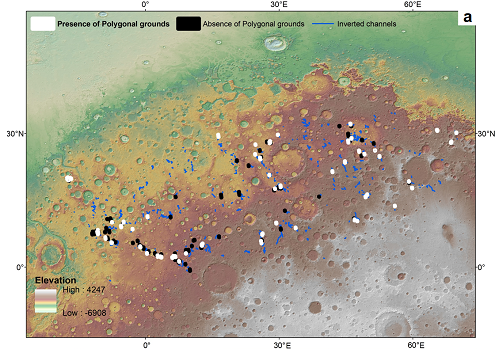
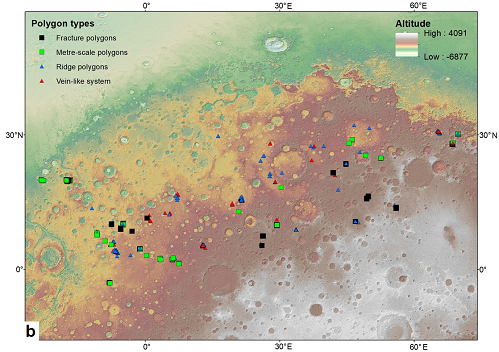
Figure 1: a-Studied HiRISE images which cover part of inverted channels(blue lines [8]). White colours indicate presence of polygonal-grounds. Black colours indicate absence of polygonal-grounds. b-Distribution of Aram Dorsum-like polygonal terrains.
Results: From the regional survey, Aram Dorsum-like polygons have been observed in association with many of inverted channels covered by HiRISE images found in Arabia Terra (Fig.2). 100 HiRISE images (out of 205 observed) have shown at least one polygonal type. The polygons have been found mainly associated with the main ridge itself or with the surrounding material adjacent to the inverted feature. Some materials close to the inverted channels may be characterised by only one type of polygonal morphology, and in this case fracture polygons or narrow ridge polygons are the most common types. Some examples of inverted channel deposits contain several types of polygonal features and it is difficult to define when a given type of polygon ends and another type begins. From the regional survey it was difficult to define a unique stratigraphic relationship between the polygonal terrains, and several inverted channels in Arabia Terra present unique morphologies and stratigraphy. However, a trend has been observed: fracture polygon types with clear morphology are usually found on top of the inverted channel, within erosional windows where the ‘capping unit’ has been removed, or on the closest associated materials. Narrow ridges or Vein-like polygons are usually developed within surrounding materials or sometimes in the lower parts of the main ridge (where exposed).Meter-scale polygons, or densely polygonal terrains, were found in proximity of craters linked to the inverted channels, or they have been observed between other polygonal fractures and between the narrow ridges polygons.
Interpretation: The Polygonal terrains have been observed in proximity to inverted channel features, on top of the ridge, along the flanks and within ridge-related materials (sometimes interpreted to be overbank deposits [7]) which could be distributed within the inverted channels in erosional windows. The identification of the same types of Aram Dorsum-like polygonal features in so many areas in Arabia Terra suggest that a common phenomenon could be found to explain their formation and development within these fluvial deposits. The persistence of the spatial distribution and a regional stratigraphical trend suggest a connection with the physical proprieties (e.g. grain size, induration, thickness) of the inverted channel deposited materials (fluvial origin) and their response to either (i) a regional stress, if the polygons formed underground as joints, or (ii) a surface process such as desiccation, thermal contraction or possibly a combination of the two. HiRISE images, selected in other areas with no inverted channels have been also checked to evaluate if such a fine-scale polygonal features could be distributed also somewhere else not in association with the inverted channel bodies. Based on preliminary observations on 10 HiRISE samples (randomly chosen) we have not been able to identify these small-scale polygonal terrains. However, since dust and impact materials were present, the survey will be expanded in future studies.
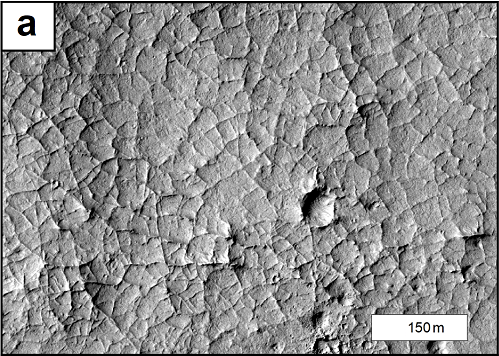
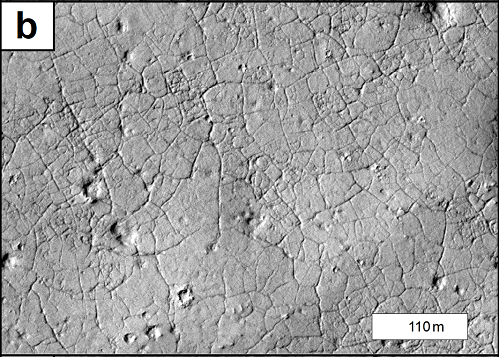
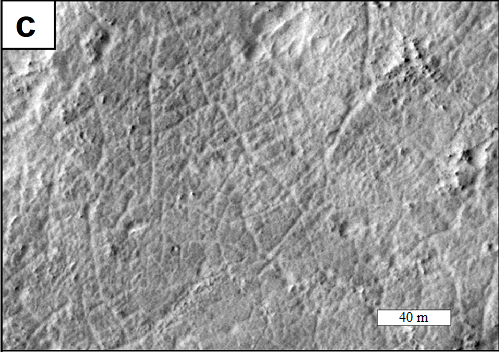
Figure 2: Example of Aram Dorsum-like polygonal terrains found in Arabia Terra region. a- Narrow ridge polygons, b- Wide fracture polygons, c- Meter-scale polygons (small domes) and Narrow fractures polygons.
Conclusions: Many other Aram Dorsum-like polygonal terrains have been observed and mapped in and around inverted channels in Arabia Terra, suggesting that inverted channels are likely to be observed associated with this type of polygonised terrains. A general spatial-stratigraphical trend has been observed, but deeper studies on selected candidates are necessary to confirm this. We will therefore perform more detailed morphological mapping choosing the a variety of inverted channel candidates in the area to further explore this possibility. More HiRISE images not associated to inverted channel bodies are also going to be controlled.
References: [1]Davis et al.,(2016), Geology, G38247.1. [2]Williams et al.,(2013), Icarus 225:308- 324. [3]Chuang & Williams,(2018), Journal of Maps, 14:2, 652-660. [4]Williams et al.,(2013), Icarus 225:308-324. [5]Williams et al.,(2007), Utah Geological Association, pp. 221-235. Salt Lake City, Publication, 36. [6]Tanaka et al.,(2014), Geologic Map of Mars: USGS Scientific Investigations Series Map 3292, scale 1:20,000,000, pamphlet 43 p. [7]Balme et al.,(2020), JGR Planets, https://doi.org/10.1029/2019JE006244. [8]Mirino et al.,(2020), LPSC 1492. [9]McEwen et al.,(2007), JGR Planets,https://doi.org/10.1029/2005JE002605. [10]Malin et al.,(2007), JGR Planets, 10.1029/2006JE002808.
How to cite: Mirino, M., Balme, M., Fawdon, P., and Grindrod, P.: Polygonal terrains associated with inverted channels in Arabia Terra, Mars., Europlanet Science Congress 2021, online, 13–24 Sep 2021, EPSC2021-332, https://doi.org/10.5194/epsc2021-332, 2021.

